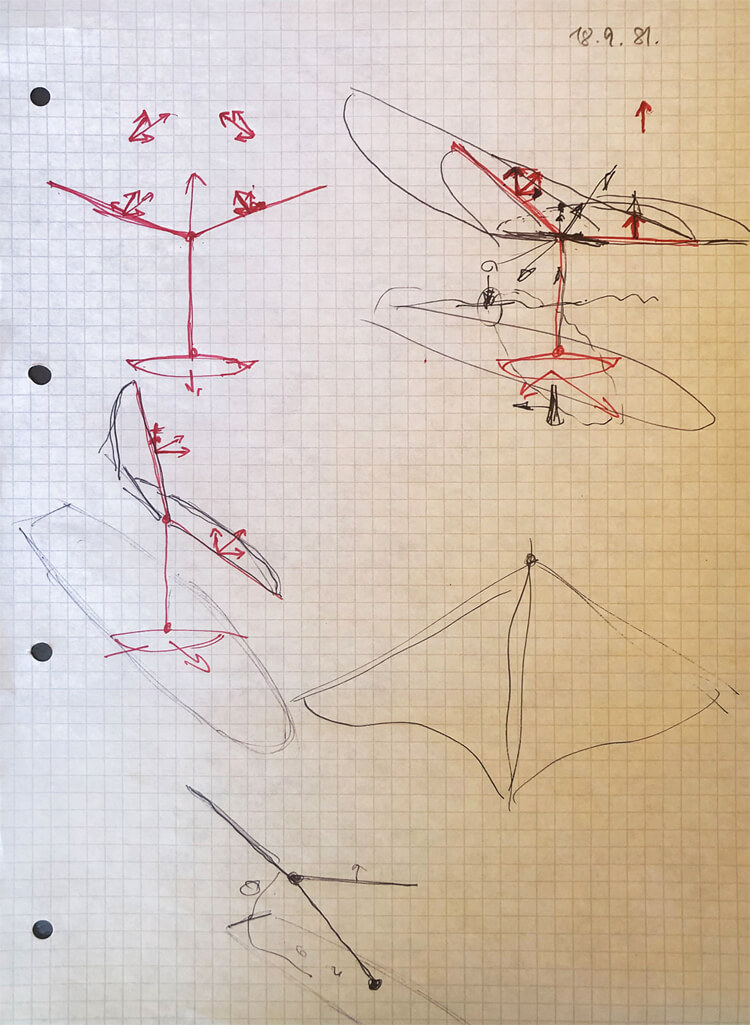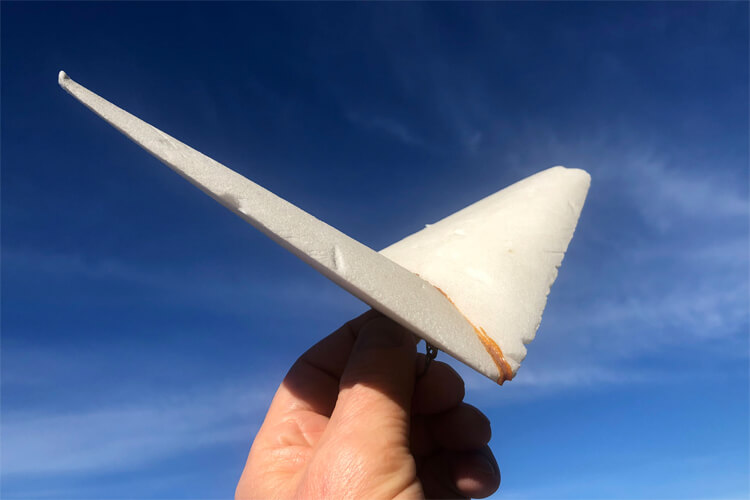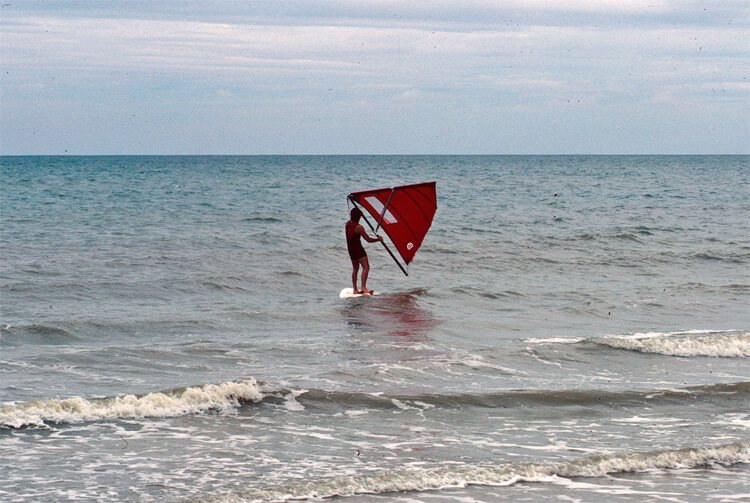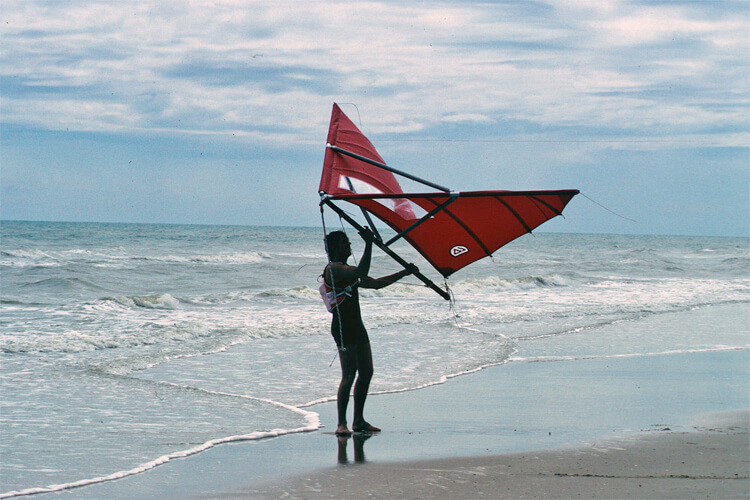The idea of the first "Wing" rig came up in August 1981 when Jim Drake visited me in the surf editorial office in Munich. It was the precursor of modern wing surfing.
Jim and I had been friends since 1977, when Surf-Magazin was founded, and my article about the "true inventor" of windsurfing was published.
So in August 1981, over dinner, we discussed our experiences that we had made over a year earlier at the PanAm Cup in Hawaii - the development of funboards and the first really high jumps over the waves.
In the meantime, during our surf tests on Gran Canaria, I had repeatedly observed flying fish that shot out of the water next to our boards and then often sailed dozens of meters next to us.
I asked Jim if we couldn't do something similar to the flying fish with our surfboards and described my observation that our typical windsurfing rigs are simply not symmetrical and that after a jump, you would tip over to one side and fall into the water.
"What if our rigs were somehow symmetrical, and you could fly a little while jumping like a flying fish?" I asked.
I had no idea what something like that might look like, but Jim's eyes immediately flashed.
He said: "I think I have the solution."

Aerodynamic Theory
As a gifted aircraft designer and aerodynamics expert, he explained the principle of his wing rig to me.
The two wing halves must be the same size, slightly angled, and have only one central boom because then the wing automatically tilts to one side or the other if you turn your nose slightly out of the wind.
To be honest, I didn't get it right away.
We made a drawing on a piece of paper, and Jim described the principle in a short text.
I was excited.
The very next day, I built a small model from a piece of surfboard foam (Clark Foam), which I still own today.
I then held the model in front of a ventilator fan to test it. Lo and behold, it worked perfectly.
Shortly after that, I suggested Jim apply for a patent on it. The idea is just too good.
Of course, this proposal was inspired by the fact that Jim Drake's former partner, Hoyle Schweitzer, administered the windsurfing patent with a hard hand, demanded high license fees, the whole industry groaned, and Drake, as the actual inventor of windsurfing, was no longer involved.
At the time, I thought it was just fair that Jim should reap the fruits of his labor with a new patent for a possibly much better rig.
Jim stated that I gave him the initial idea and that he would like to file the patent together with me.
I felt honored and said yes.

On October 13, 1981, we applied for a patent for a wing rig at the European Patent Office (EPO) in Munich.
I covered the costs, and I still own all documents from that time.
Since we really wanted to try out the wing on a board and in the wind, I asked some surfboard companies in Germany whether they would be willing to build two prototypes for us, including the sail manufacturer Deuter and Klepper.
I finally got an acceptance at the Schütz-Werke in Selters, north of Frankfurt, which at that time had just started with the Fanatic brand.
My contact was the well-known sailor Ulli Libor, who managed the surfing area.
Jim Drake and I met in October 1981 in Selters, where Jim was able to make precise technical drawings of the "Wing" in the design department, which I still have today.
Then, two rigs made of aluminum tubes were built in the prototype department of the Schütz-Werke.
At the same time, I asked my friend, sailmaker André Lefebvre (Bostalsee in Saarland), whether he would tailor two sails for us.
Jim also made a cutting plan for him with exact dimensions.
André then made three sails, a yellow one for Jim, a dark red one for me, and a green one for himself, which he later tried out on the Bostalsee with a support mast on the board.

Test Drive
Jim Drake took one of the two prototypes and the yellow sail to California and later, at the end of January 1982, to the PanAm Cup in Kailua, where Pete Cabrinha, Richard Whyte, and Randy Naish tried out the "Wing."
I took my prototype with the dark red sail to Thailand in November 1981, where I visited Bert Morsbach and his surfboard company "Cobra" in Bangkok.
Then I drove to the beach in Hua Hin, about 200 kilometers south of Bangkok, to try out the "Wing".
It was November 11, 1981, so I was the very first to try the "Wing."
Unfortunately, the conditions were not good - little wind (one or two Beaufort) and choppy waves.
I tried to get through the small surf, the rig plunged into the water, and the central boom broke on the first attempt.
I was pretty desperate, but I didn't give up.
In the afternoon, I took a carbon mast off my windsurfing rig, saw it to the right size, and built it into the wing.
The next day - November 12, 1981 - I went out again and had at least as much success that I was able to sail there and back a few times - like any beginner with a new device.
The "Wing" prototype with this dark red sail is still in my garage.
Words and Photos by Uli Stanciu
